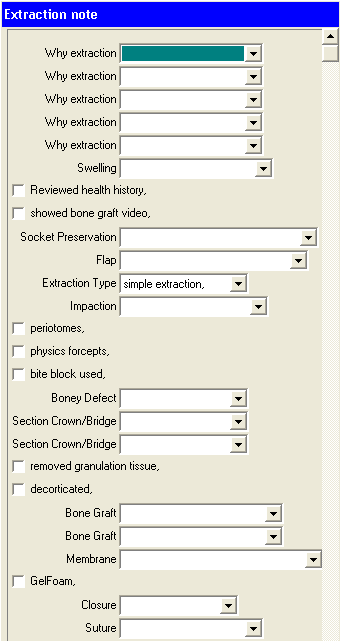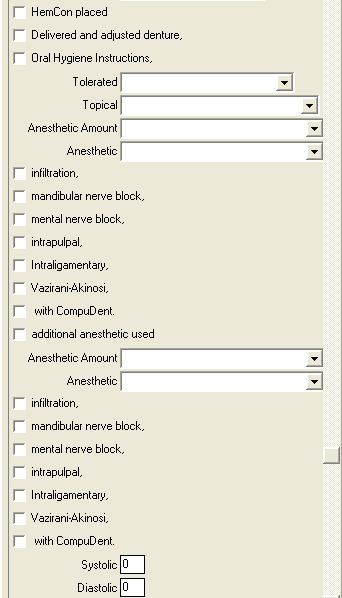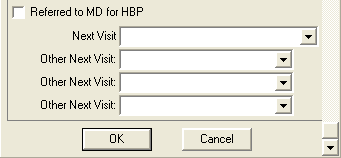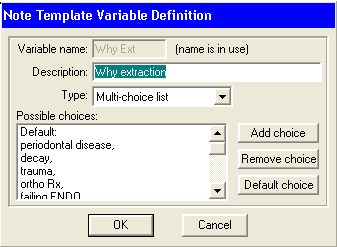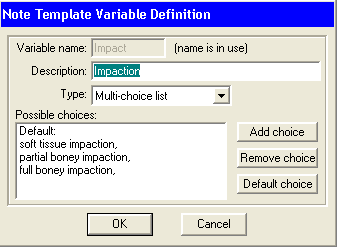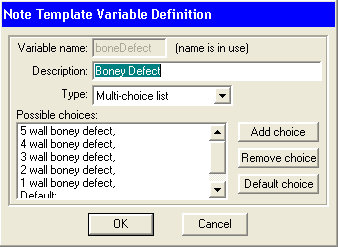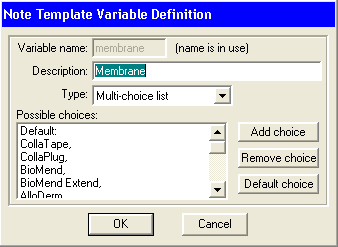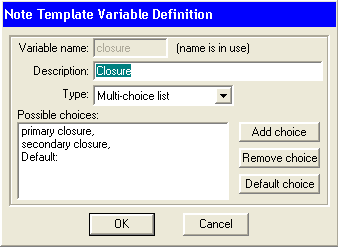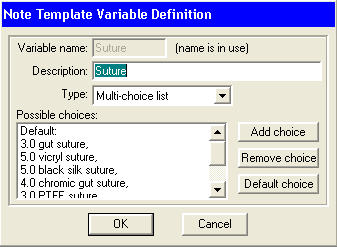Tutorial: Here is another example of how to write the code for Carestream/Kodak PracticeWorks dental chart notes. This note has evolved over the years and is still being revised daily. As new products and procedures come to the dental profession this note is added to and subtracted from according to the state-of-the-art. This note is intended for dentists who want to write the quickest and most precise notes possible.
The code is as follows:
This tooth was extracted c/o patient request, <Why Ext> <Why Ext> <Why Ext> <Why Ext> <Why Ext> <Swelling> <HlthHx> Explained the informed consent to the patient and prompted question, <video> <informBone> <Flap> <Extract> <Impact> <periotome> <physics> <biteBlock> <boneDefect> <sectBridge> <sectBridge> <granulation> <decorticate> <Bone Graft> <Bone Graft> <membrane> <gelfoam> <closure> <Suture> <hemCon> <delivery1> <OHI> <tolerated> Topical anesthetic <Topical> with <AnesNumMg> of <Anesthetic> <AnesthFil> <AnesthBlock> <AnesthMental> <AnesthPulp> <AnesthLig> <AnesthAkin><CompuDent> <addAnesth> <AnesNumMg> <Anesthetic> <AnesthFil> <AnesthBlock> <AnesthMental> <AnesthPulp> <AnesthLig> <AnesthAkin><CompuDent> Blood Pressure <BP>/<Diastolic>, Pulse <Pulse>. <HBP> <Next Visit><secNV><secNV><secNV>
The patient was informed that immediately after the extraction their tongue/lips maybe numb. This is the time to stay quiet, keep your blood pressure down by limiting physical exertions, and try not to disturb the forming clot(s). Do not eat food until your lips/tongue are un-numb or you can cause severe trauma by chewing the lips and tongue. Do not drink carbonated beverages such as cokes or beer as this may fizz out the forming clot(s). Alcoholic beverages are to be avoided because they can dissolve out the clot and can cause your pain medication to be much stronger than it is intended. Combinations of narcotics and alcohol have lead to respiratory arrest and death. Leave the gauze in your mouth for 30-45 minutes. Bite on it firmly but do not chew it. The gauze is supposed to get wet with blood and saliva so don’t “milk the clot” by changing it frequently. This will disrupt the clot formation and cause continued bleeding.
Generally, you can eat anything you want to eat after an extraction. Cold foods are better than hot because hot will increase the blood circulation in the mouth and may cause bleeding. Hard foods may be difficult to chew. Do not bother with food being lodged into or near the socket(s). The body will push it out on its own. Flushing it out yourself will disrupt the clot and may cause a “dry socket”.
Avoid rinsing your mouth for 24 hours and DO NOT use mouthwashes or peroxides. Many mouthrinses contain alcohol and can affect the clot.
CALL the office if you have any post-operative complications or need to ask a question about how to take care of yourself.
If prescribed an antibiotic, take them until they are all gone. Doing otherwise may cause recurrent infections and/or cause antibiotic resistent bacteria to populate your mouth.
When the code is activated the note asks these questions:
Fill out the questions in less than a minute and press “OK” the flowing note appears for you to look over and edit before it is posted to the patient’s chart.
This tooth was extracted c/o patient request, periodontal disease, decay, abscess, non-restorable, toothache, No swelling noted, Reviewed health history, Explained the informed consent to the patient and prompted question, showed bone graft video, pt decided to have socket grafted, small observation flap elevated, surgical extraction, physics forcepts, bite block used, 5 wall boney defect, removed bone, removed root tip(s), removed granulation tissue, decorticated, DynaBlast, sterilized calcium sulfate, BioMend Extend, secondary closure, 5.0 black silk suture, Oral Hygiene Instructions, Treatment was tolerated well. Topical anesthetic 20% lido/4% Tetra/2% phenylephrine with 1 carpule (36mg/1.7ml) of 2% Mepivacaine/1:20,000 NeoCobefrin mandibular nerve block, additional anesthetic used 1 carpule (68mg/1.7ml) 4% Articaine w/1:100000 epi infiltration, Blood Pressure 160/95, Pulse 72. Referred to MD for HBP, Next Visit: Re-eval, Cleaning/Comp exam/FMX
The patient was informed that immediately after the extraction their tongue/lips maybe numb. This is the time to stay quiet, keep your blood pressure down by limiting physical exertions, and try not to disturb the forming clot(s). Do not eat food until your lips/tongue are un-numb or you can cause severe trauma by chewing the lips and tongue. Do not drink carbonated beverages such as cokes or beer as this may fizz out the forming clot(s). Alcoholic beverages are to be avoided because they can dissolve out the clot and can cause your pain medication to be much stronger than it is intended. Combinations of narcotics and alcohol have lead to respiratory arrest and death. Leave the gauze in your mouth for 30-45 minutes. Bite on it firmly but do not chew it. The gauze is supposed to get wet with blood and saliva so don’t “milk the clot” by changing it frequently. This will disrupt the clot formation and cause continued bleeding.
Generally, you can eat anything you want to eat after an extraction. Cold foods are better than hot because hot will increase the blood circulation in the mouth and may cause bleeding. Hard foods may be difficult to chew. Do not bother with food being lodged into or near the socket(s). The body will push it out on its own. Flushing it out yourself will disrupt the clot and may cause a “dry socket”.
Avoid rinsing your mouth for 24 hours and DO NOT use mouthwashes or peroxides. Many mouthrinses contain alcohol and can affect the clot.
CALL the office if you have any post-operative complications or need to ask a question about how to take care of yourself.
If prescribed an antibiotic, take them until they are all gone. Doing otherwise may cause recurrent infections and/or cause antibiotic resistent bacteria to populate your mouth.
The best part about writing code for a procedure is that you can copy and paste bits and pieces from other note code you have already written. For this one I took the anesthesia from another note, and most of the rest from still others. Always design your variables so they can be used in more than one note and you will be able to make new notes quick and easy. Remember the check box variable are what they are, and need no explanation (but if you do need some help please review some of the other blogs like “How to Write Carestream/Kodak PracticeWorks Dental Notes: Local Anesthetics”.). However, the multi-choice variable need some explanation.
Simply writing in the chart that you extracted a tooth really isn’t good enough. This note asks you why you had to extract the tooth and gives you several different reasons to do so including periodontal disease, decay, trauma, ortho Rx, failing ENDO, cracked tooth, non-functional, supra-erupted, abscess, non-restorable, toothache, pericornitis, vertical root fracture, and parulus. You can of course add as many reasons you can possibly think of to this list, but for now these will due.
So do you give the patient antibiotics? Are you one of those ” CYA” doctors who give antibiotics to everyone or do you give your patients antibiotics for a medical reason? Well this variable gives you a reason why by asking if there is mild, moderate or severe swelling or no swelling at all.
With the availability of bone grafting products and train for general dentist on how and when to use these products, we dentist would be remiss if we did not inform our patients of such post-extraction/pre-implant treatment. This variable simply asks the patient if they want to have a bone graft of not.
Sometimes we have to elevate a flap.
The type of extraction is good to know not only for the history, but for insurance purposes.
If it was a surgical extraction it could be an impaction which is also good for history and insurance purposes.
I like to know what kind of defect was left after the extraction. Knowing the number of walls left is one way to illustrate the defect. A 5 wall boney defect of course being a totally intact extraction site.
Sometimes I have to section the tooth, a bridge, remove bone or retrieve a root tip.
The type of bone graft is always important. I have listed many of the past and current products that we use at our office including autograft (bone scrapings), allograft (puros), PepGen P-15 that I was talked into purchasing at a CE course and I haven’t found a use for it yet (thank you, Garg), Bio-Oss, BioPlant, PRP, DynaBlast, sterile calcium sulfate, OraGraft cancellous, OraGraft cortical, and beta tricalcium phosphate.
Sometimes I like to place a membrane. When I do I like to know what kind so I can evaluate its performance. There are many types and some of the ones we use are CollaTape, CollaPlug, BioMend, BioMend Extend, AlloDerm, Puros Dermis, Puros Pericardium, CytoPlast Ti non-resorbable membrane, CytoPlast non-resorbable membrane, polytetrafluoroethylene Ti membrane, polytetrafluoroethylene membrane, OraMem-Sustained absorb membrane, and Healos.
Even though you would always like to completely close an extraction site with primary closure, most of the time it is not done. Writing down how you left the extraction site may or may not be desirable to you, but I usually enter it into the chart.
Knowing the type of sutures used is good to know, especially if you need to bring the patient back to have them removed. We use many different types of sutures including 3.0 gut, 5.0 vicryl, 5.0 black silk, 4.0 chromic gut, 3.0 PTFE, 5.0 polyviolene, and 7.0 polypropylene.
The last unique variable is the number variable. Set-up one each for diastolic, systolic and pulse. We always take a BP/pulse before and sometimes after a dental extraction. Having it in this note insures that the dental assistant will take these readings.
I write notes like this for each and every extraction done at our office. I think the best documentation is the best protection for both my patients, and our practice.

